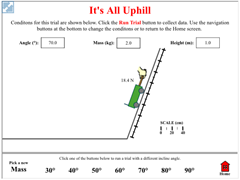 It's All Uphill
It's All Uphill
Resource:
Physics Interactives - It's All Uphill
Student Exercise - It's All Uphill
Grade Level: High School
Description:
This short activity features a simulation of a cart being pulled up a ramp, plus a companion exercise with a ready-to-use data table. It is appropriate for the beginning of a unit on Energy to help students analyze the work and energy connection. Two variables are available for manipulation: angle of the inclined plane and mass of the cart. Students use the interactive model to run multiple trials, then enter their data and perform calculations of work. Their goal is to determine the possible effect that the angle of incline has upon the amount of force and the amount of work done on a cart in pulling it up a hill at a constant speed to the same height in each trial.
This activity aligns with the three dimensions of the Next Generation Science Standards in the manner described below:
| Definitions of Energy (HS-PS3.A.2): At the macroscopic scale, energy manifests itself in multiple ways, such as in motion, sound, light, and thermal energy. |
The “It’s All Uphill” Interactive features a cart being pulled up an inclined plane. As work is done by an applied force, the object’s energy changes. In the case of this activity, the energy is manifested as a change in height of the cart. The companion Student Exercise (Analysis Questions 2-5) specifically requires students to analyze how the incline angle affects both force and work. |
| Conservation of Energy and Energy Transfer (HS-PS3.B.1): Conservation of energy means that the total change of energy in any system is always equal to the total energy transferred into or out of the system. |
The scenario in this activity involves work being done to transfer energy to a cart as it is pulled up a hill. This work results in a change in the total mechanical energy of the cart. The companion activity asks students to compare the work done to the change in potential energy of the cart as it is pulled up the incline. Students recognize the equality between the energy that is transferred to the cart by work and the change in mechanical energy of the cart. |
| Cause and Effect: Cause and effect relationships can be suggested and predicted for complex natural and human-designed systems by examining what is known about smaller scale mechanisms within the system. |
Cause and effect are investigated as students determine whether a gentler ramp requires more (or less) force and/or than a steeper ramp. Since force and displacement vectors are both directed parallel to the inclined plane and ramp length is constant at 1 meter, the activity is entirely focused on two variables: 1) the angle of the incline, and 2) the mass of the cart. |
| Scale, Proportion, and Quantity: Algebraic thinking is used to examine scientific data and predict the effect of a change in one variable on another. |
Students engage in algebraic reasoning to relate force, displacement, and work in the system of a cart being pulled up an incline. The Student Exercise provides a data table to help students with initial set-up in running trials with the interactive simulation. In the Analysis section (Questions #2-4), students use their data to describe and predict how varying the incline angle of a ramp will affect force and work. |
| Constructing Explanations: Construct an explanation based on valid and reliable evidence obtained from a variety of sources (including students' own investigations, models, theories, simulations, peer review) and the assumption that theories and laws that describe the natural world operate today as they did in the past and will continue to do so in the future. |
Students use data they collect from the Interactive to form explanations about the relationship between angle incline of a ramp, force, and work. In addition, the Conclusion section requires students to specifically explain (in writing) the effects of changing the inclined angle on amount of force required and amount of work done. Which requires more work – a gentler or steeper ramp? Which requires more force? Why? |
| Using Mathematics and Computational Thinking: Use mathematical expressions of phenomena to support claims and describe explanations. |
Using a tool in the interactive simulation to measure displacement, students will complete a data table for recording values of force and displacement. Their mathematical task is to take these values to calculate the work done. |
Associated Reading from The Physics Classroom
Other Supporting Pages at The Physics Classroom:
View Infographic.
Search the NGSS Corner
Maybe you're looking for something really specific that pertains to a desired topic and emphasizes one or more of the listed NGSS dimensions. Why not try a search of this section of our website? Simply select from one or more of the pull-down menus and click Search. This page will reload and a collection of possibilities will be displayed in this section of the page and sorted by relevancy.